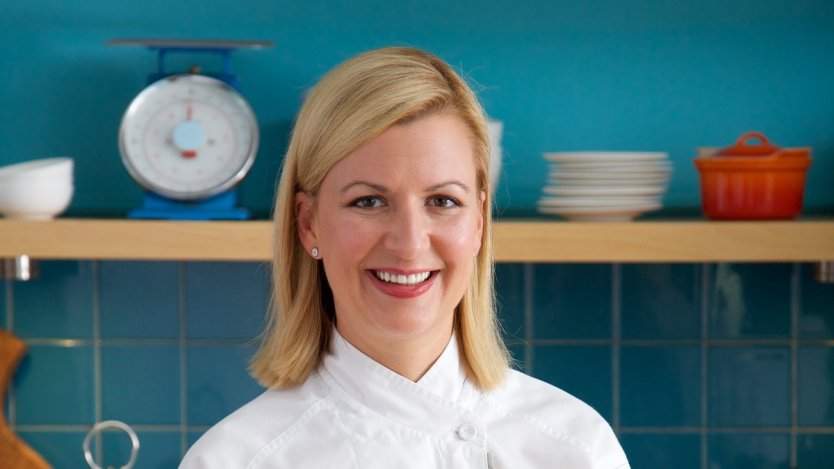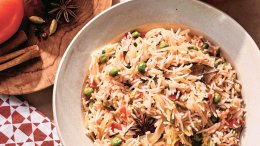Whether or not you consider yourself a serious foodie, if you were a fan of Food Network cooking shows at any point since the channel launched in 2000, chances are that you’ve seen Canadian food icon Anna Olson cooking up a storm, whether it’s desserts on Sugar and Bake with Anna Olson, or savoury family cooking with seasonal and local ingredients on Fresh. Now, Olson is back from her travels around the world and sharing her street food experiences with her new 10-part series, Inspired, where she shows just how easy it is to recreate global flavours with local ingredients. One of the key ingredients is Canadian Beef, which Olson uses in recipes like Brazilian picanha, Moroccan tagine and Middle Eastern beef kibbeh sliders.
“Six or seven years ago, when I went to Asia, I was amazed at how much Canadian beef is available there and it is seen and respected for its quality," says Olson. "It’s a premium product on display. It’s not just celebrated at home, it’s celebrated everywhere."
We chatted with Olson about her time abroad, her favourite uses for Canadian beef, and some tips we can all use in our own kitchens.
How is it switching gears back and forth from desserts to street food on your workload?
It’s a different approach, yeah. A lot of people don’t realize that I studied to be a chef first before I went into pastries The baking world is very much about how the combination of ingredients interact and control the end result. That empowers you as a savoury cook and then you know better when to bend the rules and how to bend the rules. When it comes to savoury cooking, you kind of tweak as you go. so there’s almost a little more freedom to it. When I look to a recipe that is not something I grew up with, I want to respect the heart of it. At the same time, there are ingredients you don't have access to, or elements you want to modernize or bring into your own palate, and that’s where these recipes came about.
From your travels, what cities have the most memorable street food?
My friend told me the French believe that when you go to a place for the second time, deuxième, it is actually better, because you go in focused on the things that are most important. Whereas everything is just an eye opening experience on the first trip, you go in an expert the second time. So, visiting places like Singapore and Kuala Lumpur were very special to me in a repeated visit because I knew the city and I knew the local transit system and I can go from this market to that hawker centre and feel like I own the city.
This past year, I visited Vietnam Ho Chi Minh city and the street food scene...it’s so incredible. The street food scene in Southeast Asia, in general, I think is different than we think. We think of street food here as food trucks. There, it’s about accessible food that everybody wants to eat that gives you an affordable, portable choice. In Vietnam, you don’t take away your street food. You buy it, and then in the middle of the street or on the sidewalks or the alleyways, they have these tiny little short tables and these ubiquitous little plastic red stools that you think when you sit on are just going to collapse, but with your knees up under your elbows, [you have that] bowl of noodle soup or whatever it may be. The little stall... it could be just a burner with a pot or it could be a little tiny hibachi grill cobbled together. It’s just these little quick hits. Sometimes, it’s salad and fresh colourful ingredients, sometimes it’s a broth, sometimes, it’s something that’s been stewing for an hour; so it’s just so diverse.
Is there a street food experience that stands out as the most memorable?
Yes, I would have to say my Singapore experience. Right in the heart of the financial district, so all these big tall silver and glass buildings, there is Lau Pa Sat market, which is just an old old food market. It’s become essentially more like a hawker centre, so they’re each independently-owned little food stalls. At 6 o’clock in the evening, they shut down a whole street in front of the market--so you’re not inside that market--and that’s where all the satay stalls are set up and there’s about 20 in a row. All these charcoal hibachi, charcoal grills... they’ve got satay skewers by the thousands, marinating, all different flavours, and the smoke just cascades down the street. So if you get off the subway and you don’t know where you’re going, you just follow the smoke. It could be rush hour, it doesn’t matter, tables are out on the street and you just grab a seat and they throw down the menu and you order them by the plateful. You order a dozen at a time of different varieties and different sauces. What I love about it is that you can treat it as a snack and go after work and just have four or six--because they’re really small and dainty but intensely flavoured--or you can make a meal of it [with a big group] and order a whole bunch and pass them around. There’s a very social aspect.
How do you define good street food? What do you look for?
A great little travelling tip someone gave me is when you’re going to another country, and you want to take in the street food but you don’t know, you judge a place on its condiment bottles because if they clean their condiment bottles and they look nice and fresh, you can pretty much assume that everything in the kitchen is clean and fresh and ready to go. When you see they’re all kind of sticky and sloppy, then that’s when you walk away.
Do you have a favourite beef dish in general?
My husband is a chef too. Our first conversation to start our day is, “What are we going to have for dinner tonight?” Quite often it’s based on what the season is. And it’s not that it always determines what the ingredients are, but it’s the cooking method. So, we just went from a nice warm day to -8 C so it was quickly decided that we’re not barbecuing today. One of our favourite cuts is a coulotte, it’s the sirloin cap and it is a fantastic cut because it makes two meals for us. It’s one of those cuts that you can just simply put salt and pepper on it and throw it on the grill or it can suit marinating or you can even cut it up because there’s a fat cap on the surface of it. It’s most commonly sold as a sirloin cap. [For Canadian Beef], we did the Brazilian picanha. You take this cut, and it’s kind of triangular in shape but it’s not a tri-tip. It’s just a muscle that sits on top of [the sirloin] but it’s actually quite lean because it’s just barely down from where the loin cut is.
What’s a spice or spice blend that’s best at pairing with beef that gives people the best bang for the buck?
These global spice blends are just it right now, whether it’s ras el hanout or harissa, or zaatar. There’s just so many ways to add flavour. I would say harissa for me right now; I’m going through a harissa phase. I like the hint of chile heat but there’s an aromatic side to it that I think complements. You have to pick a spice that stands up to beef, because it’s robust, so you don’t have to be shy when it comes to adding spices and flavours.
Where we live here in Welland, it’s a town of 50,000. Whenever I develop a recipe, my kind of rule is, if i can buy it in my home town, then I figure most of canada has access to it. If I can’t find it here, I’m not going to send someone else running for it.
Any tips on cooking with beef?
There’s a lot to choose from when it comes to beef. As Canadians, we’re comfortable with the the familiar things we see, names of cuts we see in restaurants, the steak cuts: the ribeye, the New York, the tenderloin. This coulotte or the sirloin cut that we discovered...I mean, for us as chefs, we probably discovered it about three years ago. Take just a few minutes to learn about these different cuts and to play with them a little bit. Because they’re not the big names, they tend to be more affordable. This is where [you can look] to global cuisines that quite often integrate these cuts. It’s just trying those cuts and learning. Sometimes, you get a better flavour. It would be a waste of money to buy a tenderloin and put it into the Moroccan tagine. Where you take an inside round--every grocery store carries it--but don’t cook it for 90 minutes, cook it for two hours so you turn it into a slow cooker dish, and then you end up with something that’s tender and delicious.













